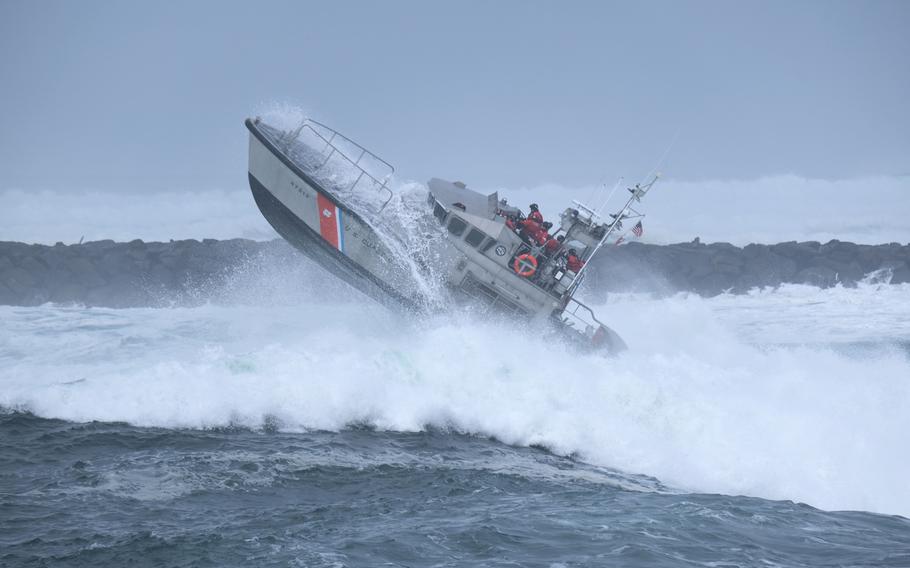
The crew of a vessel from Coast Guard Station Umpqua River, Winchester Bay, Ore., conducts heavy-weather surf training in the bay on March 15, 2022. (U.S. Coast Guard)
Half of the 39 Coast Guard units based on the Pacific Northwest coast lack tsunami evacuation plans for their personnel, despite their location in a high-risk zone for such a disaster, according to a new government watchdog report.
Among the 19 units that have written plans for evacuating Coast Guard members and their families, the content and feasibility of the documents varied widely, the Government Accountability Office wrote in a report published Wednesday.
The units are part of the Coast Guard’s District 13, whose area of responsibility includes the coastlines of Washington and Oregon.
Addressing those planning gaps requires some urgency. Emergency management authorities in Oregon alone estimate the odds of a killer earthquake at nearly 40% in the next 50 years, according to GAO. A quake that size could generate a tsunami wave similar to the one that devastated the northeastern coast of Japan in March 2011, killing tens of thousands.
The Coast Guard serves as a first responder and provides humanitarian assistance in disasters such as tsunamis, so it is of paramount importance the units maintain mission capability in the wake of a catastrophic tsunami, the GAO said.
There is particular concern about tsunami risk in the Pacific Northwest because of its proximity to the Cascadia Subduction Zone, which runs about 800 miles from Canada to the northern tip of California. It lies 50-80 miles offshore.
District 13 officials told the GAO that neither it nor its subordinate sectors had “developed or provided tsunami-specific guidance or templates to units to ensure that unit-developed plans include consistent information,” the report said.
The district’s 39 coastal units employ about 3,000 active-duty and reserve members and civilians.
GAO personnel visited 10 Coast Guard units, eight of which had written tsunami evacuation plans. “However, the feasibility of these eight plans was unknown to Coast Guard personnel located at these units because the units had not exercised their plans to assess feasibility, according to unit leadership,” the report said.
Tsunamis are a routine but often deadly feature of the Pacific Ocean. Tsunami waves are created by water displaced by underwater earthquakes as tectonic plates shift. The force can carry waves thousands of miles across the ocean, sometimes at astounding speeds.
The fault line for the massive Pacific Plate runs from Alaska to the Solomon Islands, from Japan to just off the American West Coast, where it meets the Juan de Fuca tectonic plate in the Pacific Northwest.
An earthquake along the Pacific Plate’s fault line in March 2011 created waves higher than 130 feet that crashed into Japan’s eastern coast. The disaster killed roughly 16,000 people and flattened entire communities. It led to the near meltdown of the Fukushima Daiichi Nuclear Power Plant.
In the Cascadia Subduction Zone, the Juan de Fuca plate is being thrust under the North American plate, a movement geologists refer to as subduction.
Subduction zones produce some of the world’s largest earthquakes, as well as the massive tsunamis that accompany them, the GAO said.
“According to the Oregon Office of Emergency Management, scientists estimate there is a 37 percent chance that a magnitude 7.1 or greater [Cascadia Subduction Zone] event will occur in the Pacific Northwest within the next fifty years,” the GAO said.
A “full rupture” of the Cascadia fault could create a tsunami wave of up to 80 feet that would reach the Washington and Oregon coast in 10 to 30 minutes, the GAO said.
The Federal Emergency Management Agency estimates that such an event could kill 14,000 people, injure more than 100,000 and damage more than 600,000 buildings, according to the GAO.
The GAO report recommended that all coastal units in the Pacific Northwest develop location specific evacuation plans. It also recommended that the commandant of the Coast Guard provide evacuation planning guidance and protocols and assess feasibility of such plans through regular exercises.
The Department of Homeland Security concurred with the GAO’s recommendations.